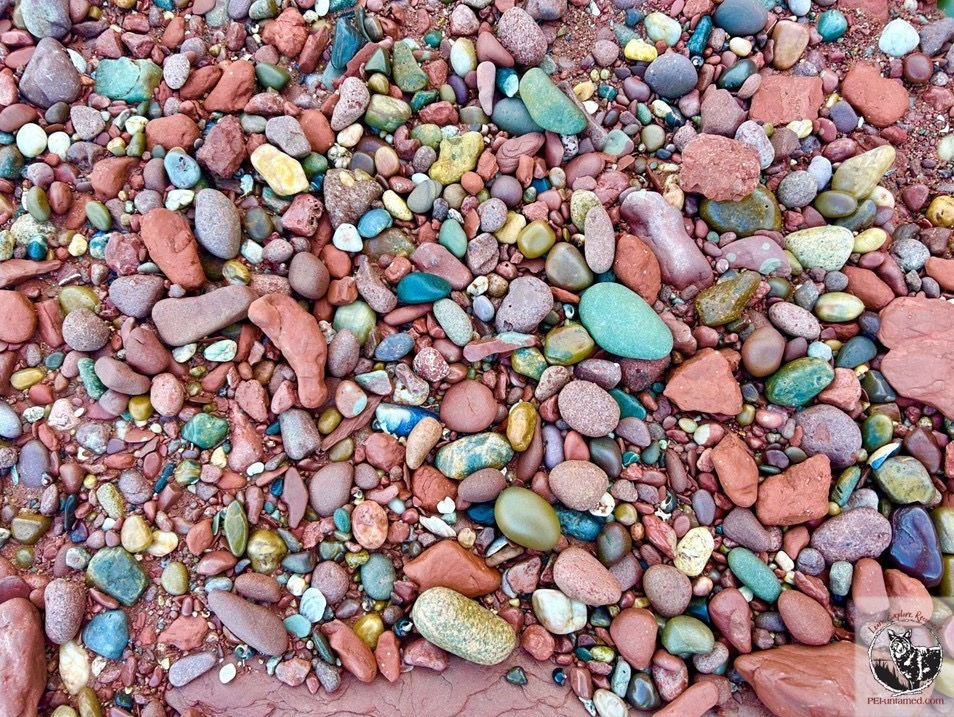Pebbles
- katemacquarrie22
- Aug 17
- 3 min read
Too often, I hear people say that PEI is geologically dull. Sure, our bedrock is all sedimentary sandstone (except for the igneous Iron Rock in Malpeque Bay), but we are rich in globally-significant fossils and have pebble beaches that can hold my attention for hours. I’ve written about some of our fossils before, but let’s look at those pebbles today.

A pebble isn’t a particular type of rock, but rather a particular size. True pebbles are between 4 and 64 mm (0.16 to 2.52 inches) in diameter and have often been smoothed by eons of wind, water, ice, and friction. Technically, some of the rocks in this photo are larger cobbles (64 to 256 mm [2.52 to 10.1 inches]), but we non-geologists commonly just call all small, roundish stones pebbles.
There are three basic types of rock – sedimentary, igneous, and metamorphic – and you can find pebbles of each. Sedimentary rock is formed from layers of sediment that accumulate over time and eventually become compacted into rock. Igneous rock is made from the cooling of hot, liquid rock (magma). When igneous or sedimentary rocks are subjected to extreme heat and pressure within the Earth’s crust, they can fracture, melt, mix, and be transformed into metamorphic rock.
Pebbles come from bedrock and can be local or transported from elsewhere. There are sandstone pebbles from the Island’s Permian redbeds in the photo, but you can see many that clearly aren’t sandstone. Some of these may have originated on the mainland and were brought ashore by wind and tides. Most came from further afield and were left when the glaciers that covered our area during the last Ice Age melted, around 12,500 years ago.
You don’t have to be a geologist to appreciate the beauty and diversity of this little slice of PEI shoreline. How may different types of pebbles can you spot?
There’s sedimentary sandstone in red (oxidized), green-grey (unoxidized), and with perfectly round reduction spheroids (bits of metal that are reversing the oxidation). Some rocks are fine grained – these were formed under slow-moving water – while others have larger stones embedded and record periods of faster-flowing, ancient floodwater about 300 million years ago.
There’s igneous granite with specks of white, pink, and dark green or brown. Those specks are different types of minerals – quartz, feldspar, or hornblende for example – and their size tells you how the rock was formed. Larger crystals are found in igneous rock that cooled slowly deep within the Earth’s crust, while small crystals indicate the rock cooled relatively quickly and formed closer to the surface. The oldest rocks on Earth are igneous – some from northern Canada have been dated at more than four billion years old – though the granite of eastern Canada is more commonly in the range of 375 million years.
There’s metamorphic quartzite that started out as quartz-rich sandstone but was transformed by immense heat and pressure within the Earth to something much harder. There’s some gneiss – metamorphic rock transformed from sedimentary – and lots with various colours and minerals that I can’t identify.
There’s also evidence of the biological mixed in with the physical. Beautiful snail shells in various shades of red, brown, blue, and white, along with blue mussel shells, and bits of white oyster, clam, and quahog shells. A few of the pebbles sport the handiwork of Piddock Clams: I’ll tell you more about those next week.
Rockhounding is a great way to explore coastal areas of PEI Untamed!



